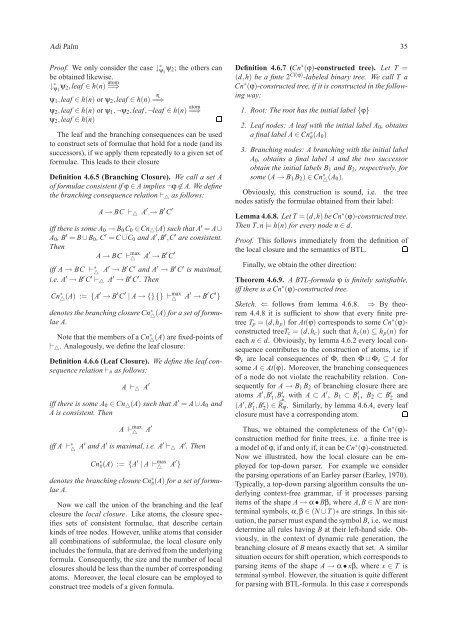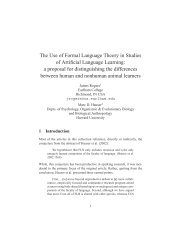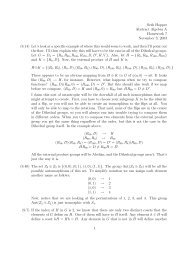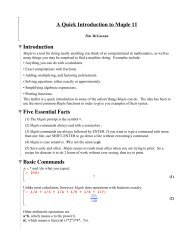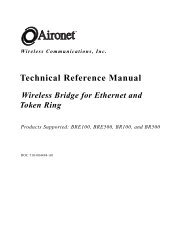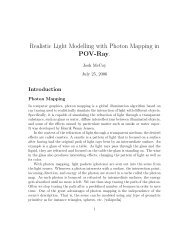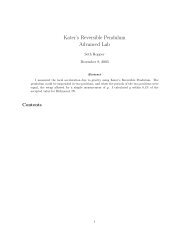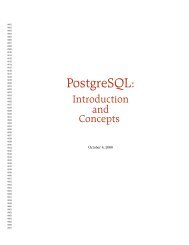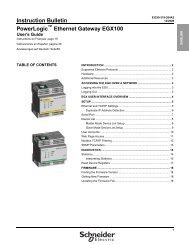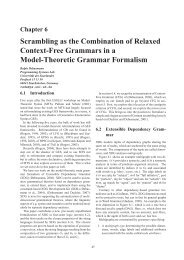Model-Theoretic Syntax at 10 - Earlham Computer Science ...
Model-Theoretic Syntax at 10 - Earlham Computer Science ...
Model-Theoretic Syntax at 10 - Earlham Computer Science ...
You also want an ePaper? Increase the reach of your titles
YUMPU automatically turns print PDFs into web optimized ePapers that Google loves.
Adi Palm 35<br />
Proof. We only consider the case ↓ ∗ ψ 1<br />
ψ 2 ; the others can<br />
be obtained likewise.<br />
↓ ∗ ψ 1<br />
ψ 2 ,leaf ∈ h(n) =⇒<br />
<strong>at</strong>om<br />
ψ 1 ,leaf ∈ h(n) or ψ 2 ,leaf ∈ h(n) =⇒<br />
R<br />
ψ 2 ,leaf ∈ h(n) or ψ 1 ,¬ψ 2 ,leaf,¬leaf ∈ h(n) =⇒<br />
<strong>at</strong>om<br />
ψ 2 ,leaf ∈ h(n)<br />
The leaf and the branching consequences can be used<br />
to construct sets of formulae th<strong>at</strong> hold for a node (and its<br />
successors), if we apply them repe<strong>at</strong>edly to a given set of<br />
formulae. This leads to their closure<br />
Definition 4.6.5 (Branching Closure). We call a set A<br />
of formulae consistent if ϕ ∈ A implies ¬ϕ ∉ A. We define<br />
the branching consequence rel<strong>at</strong>ion ⊢ △ as follows:<br />
A → BC ⊢ △ A ′ → B ′ C ′<br />
iff there is some A 0 → B 0 C 0 ∈ Cn △ (A) such th<strong>at</strong> A ′ = A∪<br />
A 0 , B ′ = B ∪ B 0 , C ′ = C ∪C 0 and A ′ ,B ′ ,C ′ are consistent.<br />
Then<br />
A → BC ⊢ max<br />
△ A′ → B ′ C ′<br />
iff A → BC ⊢ ∗ △<br />
A′ → B ′ C ′ and A ′ → B ′ C ′ is maximal,<br />
i.e. A ′ → B ′ C ′ ⊢ △ A ′ → B ′ C ′ . Then<br />
Cn ∗ △ (A) := {A′ → B ′ C ′ | A → {}{} ⊢ max<br />
△ A′ → B ′ C ′ }<br />
denotes the branching closure Cn ∗ △<br />
(A) for a set of formulae<br />
A.<br />
Note th<strong>at</strong> the members of a Cn ∗ △<br />
(A) are fixed-points of<br />
⊢ △ . Analogously, we define the leaf closure:<br />
Definition 4.6.6 (Leaf Closure). We define the leaf consequence<br />
rel<strong>at</strong>ion ⊢ # as follows:<br />
A ⊢ △ A ′<br />
iff there is some A 0 ∈ Cn △ (A) such th<strong>at</strong> A ′ = A ∪ A 0 and<br />
A is consistent. Then<br />
A ⊢ max<br />
△ A′<br />
iff A ⊢ ∗ △ A′ and A ′ is maximal, i.e. A ′ ⊢ △ A ′ . Then<br />
Cn ∗ # (A) := {A′ | A ⊢ max<br />
△ A′ }<br />
denotes the branching closure Cn ∗ #(A) for a set of formulae<br />
A.<br />
Now we call the union of the branching and the leaf<br />
closure the local closure. Like <strong>at</strong>oms, the closure specifies<br />
sets of consistent formulae, th<strong>at</strong> describe certain<br />
kinds of tree nodes. However, unlike <strong>at</strong>oms th<strong>at</strong> consider<br />
all combin<strong>at</strong>ions of subformulae, the local closure only<br />
includes the formula, th<strong>at</strong> are derived from the underlying<br />
formula. Consequently, the size and the number of local<br />
closures should be less than the number of corresponding<br />
<strong>at</strong>oms. Moreover, the local closure can be employed to<br />
construct tree models of a given formula.<br />
Definition 4.6.7 (Cn ∗ (ϕ)-constructed tree). Let T =<br />
(d,h) be a finte 2 Cl(ϕ) -labeled binary tree. We call T a<br />
Cn ∗ (ϕ)-constructed tree, if it is constructed in the following<br />
way:<br />
1. Root: The root has the initial label {ϕ}<br />
2. Leaf nodes: A leaf with the initial label A 0 , obtains<br />
a final label A ∈ Cn ∗ # (A 0)<br />
3. Branching nodes: A branching with the initial label<br />
A 0 , obtains a final label A and the two successor<br />
obtain the initial labels B 1 and B 2 , respectively, for<br />
some (A → B 1 B 2 ) ∈ Cn ∗ △ (A 0).<br />
Obviously, this construction is sound, i.e. the tree<br />
nodes s<strong>at</strong>isfy the formulae obtained from their label:<br />
Lemma 4.6.8. Let T =(d,h) be Cn ∗ (ϕ)-constructed tree.<br />
Then T,n |= h(n) for every node n ∈ d.<br />
Proof. This follows immedi<strong>at</strong>ely from the definition of<br />
the local closure and the semantics of BTL.<br />
Finally, we obtain the other direction:<br />
Theorem 4.6.9. A BTL-formula ϕ is finitely s<strong>at</strong>isfiable,<br />
iff there is a Cn ∗ (ϕ)-constructed tree.<br />
Sketch. ⇐ follows from lemma 4.6.8. ⇒ By theorem<br />
4.4.8 it is sufficient to show th<strong>at</strong> every finite pretree<br />
T p = (d,h p ) for At(ϕ) corresponds to some Cn ∗ (ϕ)-<br />
constructed treeT c = (d,h c ) such th<strong>at</strong> h c (n) ⊆ h p (n) for<br />
each n ∈ d. Obviously, by lemma 4.6.2 every local consequence<br />
contributes to the construction of <strong>at</strong>oms, i.e if<br />
Φ c are local consequences of Φ, then Φ ∪ Φ c ⊆ A for<br />
some A ∈ At(ϕ). Moreover, the branching consequences<br />
of a node do not viol<strong>at</strong>e the reachability rel<strong>at</strong>ion. Consequently<br />
for A → B 1 B 2 of branching closure there are<br />
<strong>at</strong>oms A ′ ,B ′ 1 ,B′ 2 with A ⊂ A′ , B 1 ⊂ B ′ 1 , B 2 ⊂ B ′ 2 and<br />
(A ′ ,B ′ 1 ,B′ 2 ) ∈ ̂R ϕ . Similarly, by lemma 4.6.4, every leaf<br />
closure must have a corresponding <strong>at</strong>om.<br />
Thus, we obtained the completeness of the Cn ∗ (ϕ)-<br />
construction method for finite trees, i.e. a finite tree is<br />
a model of ϕ, if and only if, it can be Cn ∗ (ϕ)-constructed.<br />
Now we illustr<strong>at</strong>ed, how the local closure can be employed<br />
for top-down parser. For example we consider<br />
the parsing oper<strong>at</strong>ions of an Earley parser (Earley, 1970).<br />
Typically, a top-down parsing algorithm consults the underlying<br />
context-free grammar, if it processes parsing<br />
items of the shape A → α • Bβ, where A,B ∈ N are nonterminal<br />
symbols, α,β ∈ (N ∪ T)∗ are strings. In this situ<strong>at</strong>ion,<br />
the parser must expand the symbol B, i.e. we must<br />
determine all rules having B <strong>at</strong> their left-hand side. Obviously,<br />
in the context of dynamic rule gener<strong>at</strong>ion, the<br />
branching closure of B means exactly th<strong>at</strong> set. A similar<br />
situ<strong>at</strong>ion occurs for shift oper<strong>at</strong>ion, which corresponds to<br />
parsing items of the shape A → α • xβ, where x ∈ T is<br />
terminal symbol. However, the situ<strong>at</strong>ion is quite different<br />
for parsing with BTL-formula. In this case x corresponds


